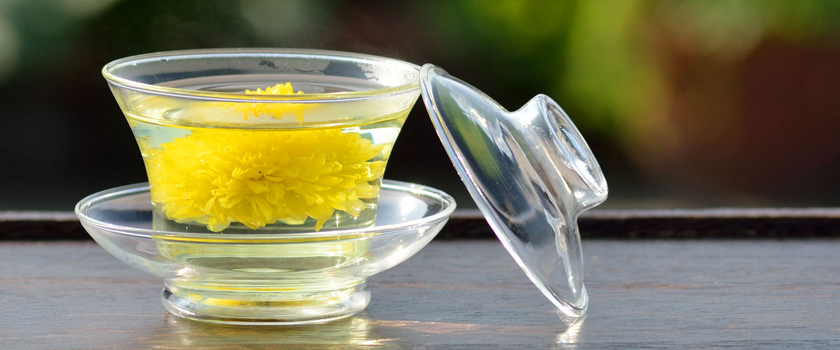The Chinese have a special emotion on chrysanthemum ever since thousands of years ago. In the eyes of poets, it represents nobleness, loftiness, and free from vulgarity. For ordinary people, it is the symbol of auspiciousness and longevity. Chrysanthemum, together with plum blossom, orchid and bamboo, are regarded as the four gentlemen among other flowers.
Apart from its aesthetic beauty, chrysanthemum has a wide use in medicine. The famous herbal tea, chrysanthemum tea, is as common as the green tea or red tea in many Chinese families.
Among all the breeds, the most famous shall be the Hangzhou White Chrysanthemum produced in Tongxiang City, Zhejiang and the Tribute Chrysanthemum of Mount Huang (or Huizhou Tribute Chrysanthemum) at the foot of Mount Huang.
The Tribute Chrysanthemum of Mount Huang in particular, which grows on the high mountain, is a healthier drink for modern people since it’s not contaminated at all. Another difference between the two breeds is the preparation into medicine.
The Hangzhou White Chrysanthemum is picked up and then steamed before dried in the sun, while the Tribute Chrysanthemum is directly dried. As a result, the White Chrysanthemum looks brighter and lighter, and the Tribute Chrysanthemum a little bit darker.
When choosing the flower, choose the big one with heavy petals, which is better for making chrysanthemum tea. Put four to six flowers in a cup, add some boiled water and you can enjoy it in five minutes.
Most people prefer making the tea only with chrysanthemums, but some may like to put a small amount of green tea in it. If you use a transparent glass, you can appreciate the process of the dry flowers once blossoming in the water, and the water gradually become yellowish.
Normally, rock sugar is added to make the tea more tasty. The steam of the hot tea can be fully used to relieve your eyes from longtime-computer-staring when you put the glass under your eyes. Three cups of chrysanthemum tea are enough for one day.
According to traditional Chinese medicine, chrysanthemum is slightly cold in nature with sweet flavor and the effects of dispelling wind heat, suppressing hyperactive liver and improving eyesight.
The medicinal uses of chrysanthemum tea include an aid in recovery from influenza and acne. Modern medicine science have also proved upon research that chrysanthemum can help to lower blood pressure, remove cancer cells, expand the coronary artery and prevent bacterial contamination.
Long-time drinking of the tea can help increase calcium in human body, regulate myocardial function and reduce cholesterol, which is especially good for people at middle or senior ages or for preventing the epidemic conjunctivitis.
It’s also good for eye dryness caused by irascibility or excessive use of eye. Meanwhile, the chrysanthemum tea is rich in aroma and refreshing, which also helps to relax and relieve headache.
However, there are some people who are not suitable to drink chrysanthemum tea frequently. Those who are diabetic and are taking insulin should avoid using chrysanthemum tea as it may interact with insulin.
Since the tea can lower blood pressure, it is not recommended to people who with delicate health or low blood pressure. Those who have digestion problem or diarrhea should avoid the tea either.
If you are not sure whether you are allergic to chrysanthemum, try the tea with one or two flowers in it. Once the test is clear, congratulations, you can fully enjoy the wonderful use of chrysanthemum tea.









